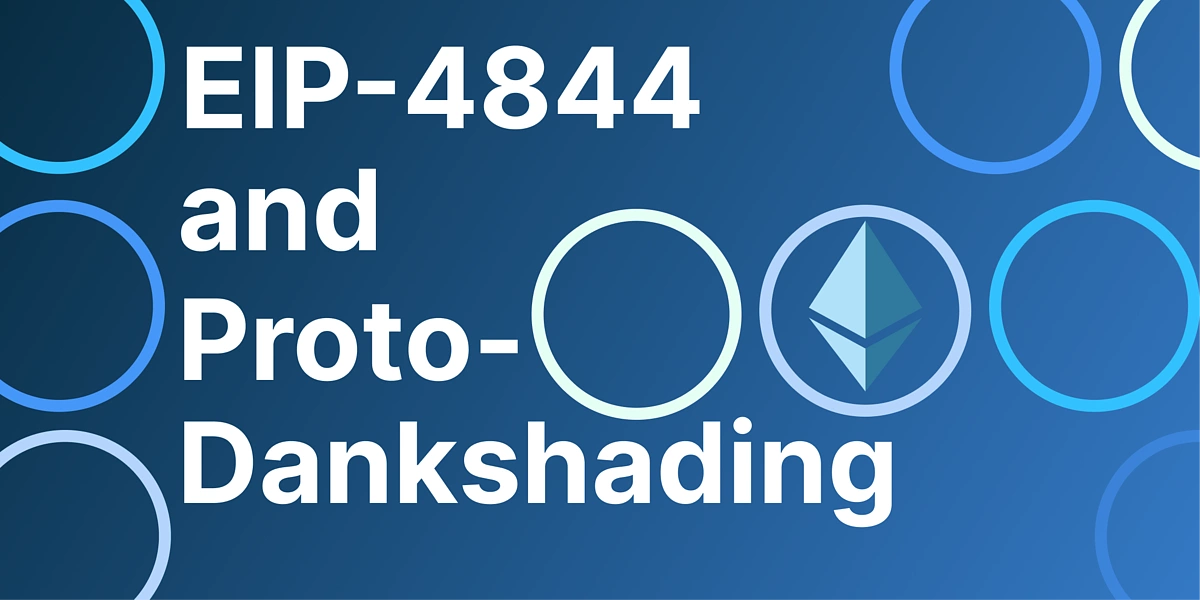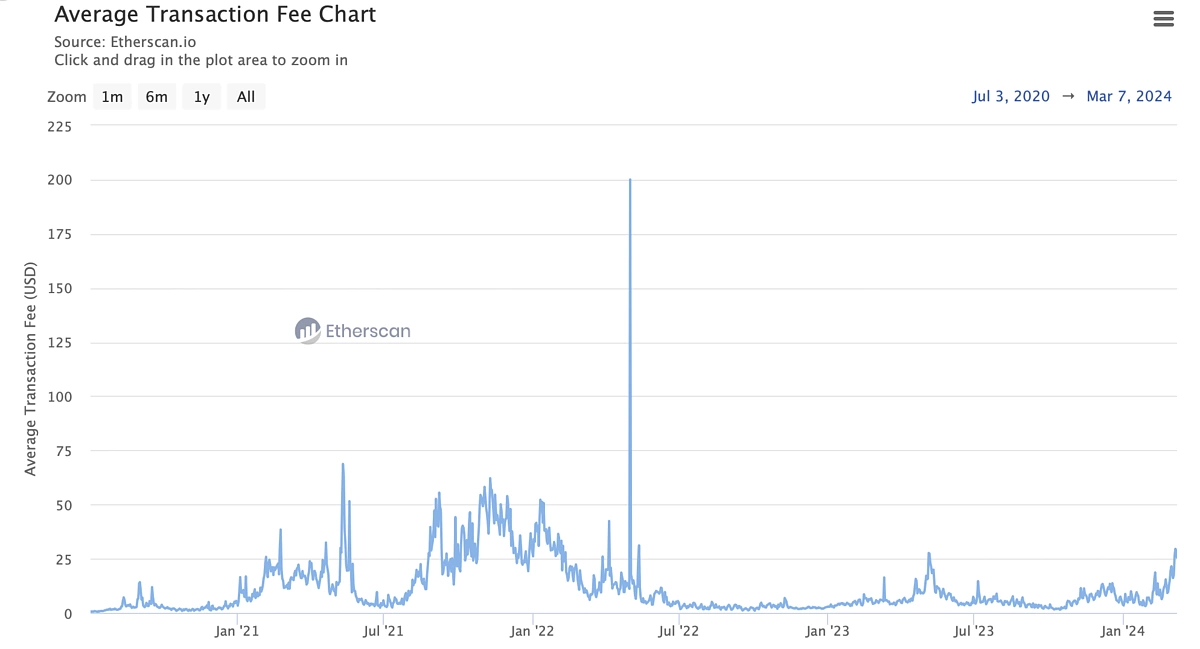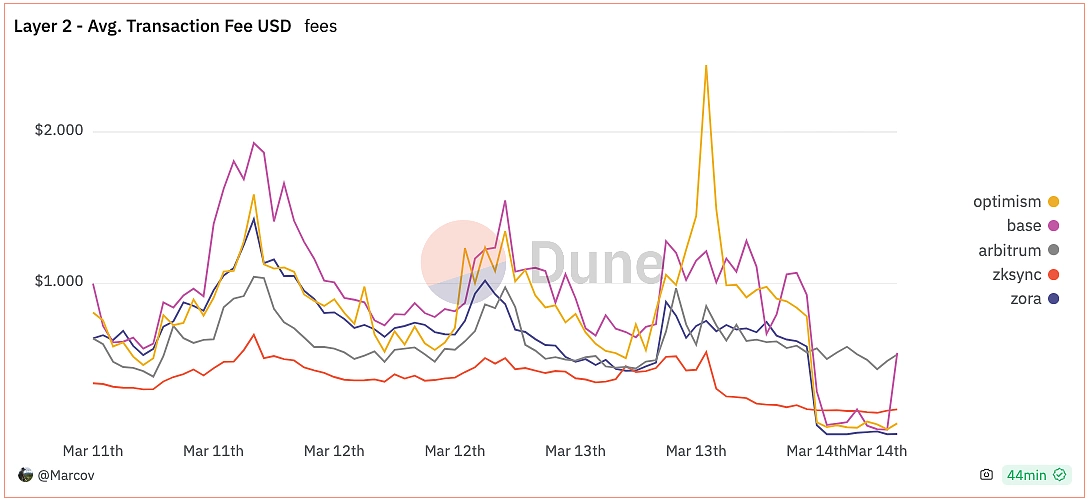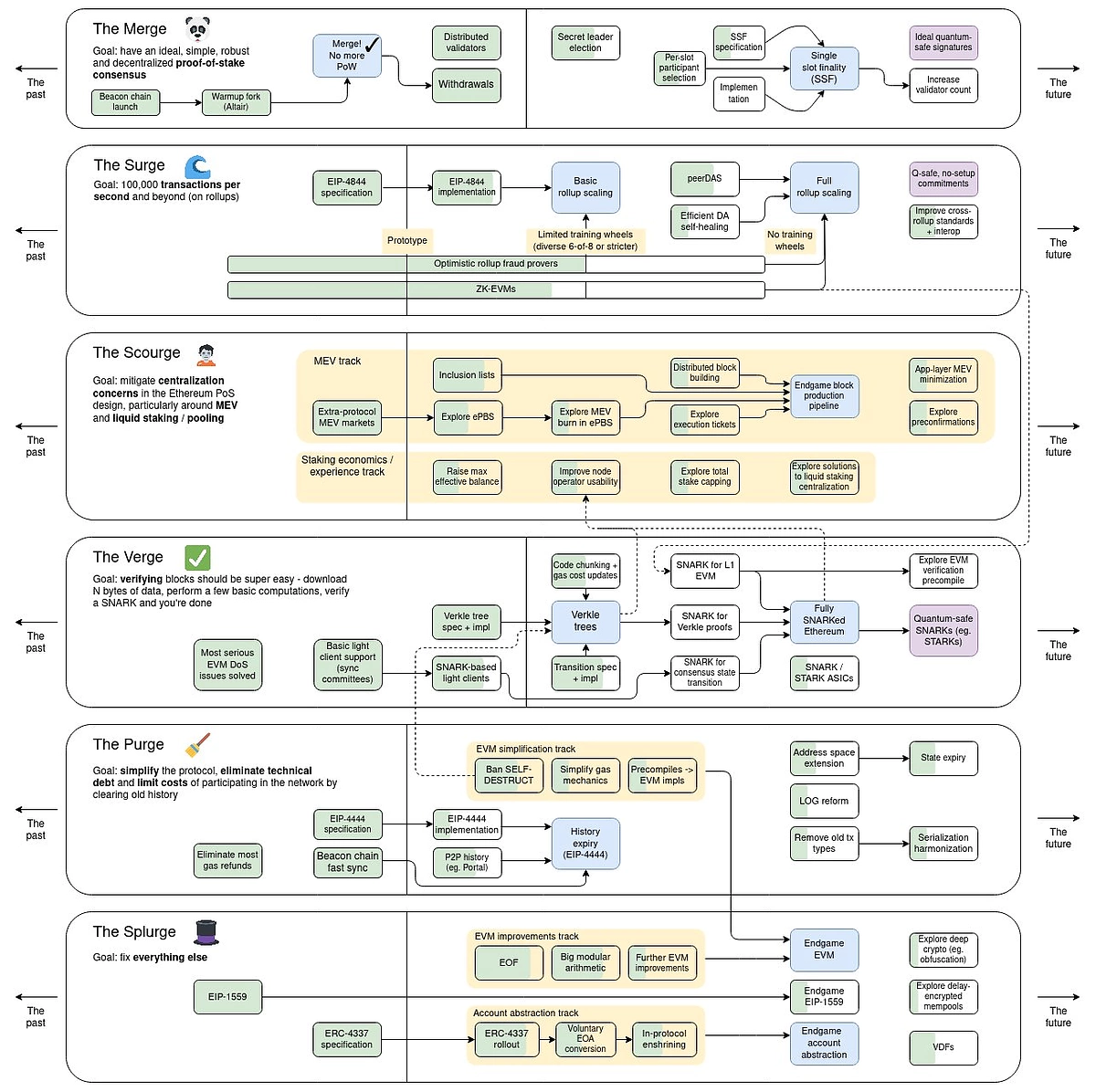What Is EIP-4844?
EIP-4844 is an Ethereum upgrade to reduce transaction costs, specifically on Layer 2s, and improve scalability through Proto-Danksharding. This introduces "blob-carrying transactions” – a sort of temporary storage – which would offload “blobs” to special shards.
Key Takeaways
-
Sharding is adopted as the long-term solution for Ethereum’s scalability challenges.
-
EIP-4844 (a.k.a. proto-danksharding) lays the groundwork for danksharding. Danksharding is a scaling solution for Ethereum focusing on optimized data availability and shard block production without increasing the load on validators.
-
EIP-4844 primarily targets rollup fees, not directly affecting the cost of transactions on the Ethereum mainnet, with fees on Layer 2s going as low as $0.01 on Base.
-
EIP-4844 introduces blob-carrying transactions, a new transaction type, and a multi-dimensional fee market.

The Ethereum network has grown to be a sort of “world computer” for most on-chain assets and smart contracts. It is the largest blockchain in terms of TVL. Despite shaping the future of decentralized finance, Ethereum is notorious for its high gas fees.
Users have to pay transaction fees every time they interact with the blockchain. This fee is used to keep the network running by paying those who maintain and manage the infrastructure. Ideally, a public blockchain should be able to run on minimal resources to bring down costs and pave the way for mass adoption.
Historically, average transaction fees has reached a high of over $200 at times of congestion, and is currently over $20. Such high fees make ETH impractical for sending and receiving small amounts, as is the case with everyday transactions.

In the effort to make Ethereum more practical for daily users, the concept of ‘sharding’ the Ethereum blockchain emerged in 2016. Today, with the implementation of EIP-4844, sharding is closer to reality than ever.
This article will explore EIP-4844 and its implementation of proto-danksharding.
What Is EIP-4844 and Proto-Danksharding
EIP-4844 is an Ethereum Improvement Proposal that would be implemented as an interim upgrade to the Ethereum network, while the blockchain proceeds to undergo full danksharding in the future.
“EIP-4844 is an upgrade that adds block space to the Ethereum network.”
- Dankrad Fiest | Ethereum Researcher, Co-Author of EIP-4844
Ethereum, since its inception, has faced challenges related to scalability, transaction speed, and high gas fees.
The network's shift from Proof of Work (PoW) to Proof of Stake (PoS) with the Ethereum 2.0 upgrade marked a significant step in addressing these issues. However, gas fees remained a blocker for most users. Sharding, a process that splits the blockchain into many parts, was accepted as the long-term solution to lower Ethereum gas fees.
Sharding a blockchain, especially one as big and active as Ethereum, is no easy feat. Therefore, Dankrad Fiest, a researcher at the Ethereum Foundation, proposed a unique way of sharding, which was accepted by the rest of the Ethereum community due to its simplicity and practicality.
Traditional blockchain sharding aimed to enhance Ethereum's transaction processing capacity by dividing the network into smaller segments (shards), each capable of processing transactions independently. This approach faced challenges, such as potential security risks with fewer validators per shard and the complex process of data migration between shards.
Instead of sharding the entire blockchain state, Dankrad’s method focuses on sharding data storage. This means that instead of storing a full copy of the blockchain state, nodes would only need to store parts of the data. This new way of sharding the blockchain was named “Danksharding”, after the author.
Danksharding is primarily designed to augment the performance of Layer 2 rollups like Arbitrum and Optimism, which handle transactions off-chain and then batch and post them to the Ethereum mainnet.
Before sharding the Ethereum blockchain, Ethereum developers (one of them was Diederik Loerakker, a.k.a. protolambda) concluded they first needed to implement a simpler version. Together, they authored EIP-4844 and proposed ‘proto-danksharding’ (a portmanteau of “protolambda” and “danksharding”). Proto-Danksharding only attaches one blob to a block, but by the time full Danksharding is achieved, there will be 64 blobs to a block.

Proto-danksharding does not scale the blockchain entirely, instead, it paves the way to shard the blockchain by introducing a new type of transaction.
How Does EIP-4844 Work?
EIP-4844 introduces the concept of "blob-carrying transactions." These are a new type of transactions on the Ethereum network that can carry large amounts of data (blobs, short for “Binary Large Objects”) at a much lower cost compared to regular transactions. And EIP-4844 "bolts blobs onto blocks," as succintly put by Ethereum contributor Ben Edgington.
“We’re building a blockchain that maintains the full security as we are used to, anti-serialization from Ethereum, but does it by providing a data availability layer that scales beyond what the individual node can process.”
- Dankrad Fiest | Ethereum Researcher, Co-Author of EIP-4844
Blobs in EIP-4844

"Blobs" refer to large chunks of data that are included in certain types of Ethereum transactions. The concept of blobs is central to the proposal's strategy for improving the scalability of the Ethereum network.
The idea behind blobs is to store data that is not immediately necessary for the operation of the Ethereum blockchain. This data can be referenced and used by off-chain systems, such as Layer 2 scaling solutions like rollups.
Therefore, blobs are stored in Ethereum’s consensus layer, not the more computationally intensive execution layer, and away from the EVM.
Further, since blob data is not permanent, and is deleted approximately every 2 weeks, it would inherently lower storage requirements for Ethereum nodes, making it very cost-effective.
Blobs are essentially an alternative to CALLDATA when they are used. While they are much larger (about 125kB), blobs are cheaper than CALLDATA because they are temporary.
To process blobs, a new type of transaction is introduced — blob-carrying transactions.
How Proto-Danksharding Scales Ethereum Layer 2s
Layer 2 solutions like rollups bundle transactions off-chain and then submit them to the main Ethereum blockchain in batches. This reduces the load on the main chain and brings down fees.
However, rollups themselves rely on including data in the form of CALLDATA on the main chain, which can still be expensive.
Blob transactions are a new type of transaction that help reduce bloat on the blockchain.
Counterintuitively, blobs are not smaller in size - they can be as large as 128kB per blob. The innovation lies in the fact that they are purged after a short period (few weeks). As a result, storage is freed up on the chain that consequently scales the network.
Let’s break this down using an analogy.
The batch of transactions that a rollup posts to the main chain consists of two parts:
-
Data of all transactions
-
Execution check by a prover
Think of this process like a football game. The transaction data in a rollup is a list of all moves that players make, where as the execution check is like a referee who double-checks the footage for any unfair play or misconduct.
Sensibly, this “list of moves” (transaction data) has to only exist long enough for the “referee” (prover) to review and make a decision. Once the decision is made, the footage can be deleted to make space for the next footage.
Earlier, this data was in the form of CALLDATA, which is permanent. Basically, the hard drive that stores the footage used to fill up quickly and new ones had to be bought which was expensive.
Now, with blobs, the old hard drives can be reused because the data is automatically deleted. Thus, reducing costs and making room for more utility within the space.
How Does Proto-Danksharding Reduce Gas Fees?
While EIP-4844 does not provide full scalability to Ethereum, it is the stepping stone to lower gas fees. Note that the gas fees reduced through EIP-4844 are on Layer 2, not Layer 1. The data storage costs Layer 2 solutions on the Ethereum mainnet would become 10 to 100 times cheaper.
Proto-danksharding considerably lowers gas fees mainly by the following:
-
Having more data capacity: Blobs are very large non-persistent data packets that free up storage through deletion.
-
Increasing efficiency for Layer 2 solutions: Rollups can process many transactions off-chain and then post the aggregated data to the Ethereum blockchain as a single blob.
-
Offloading transaction data to blobs: A substantial amount of transaction data is offloaded from the Ethereum mainnet to blobs.
-
Reducing on-chain data storage: More data is processed off-chain, which reduces the amount of data that needs to be stored on-chain.
Since more transaction data is included within each Ethereum block post the implementation of proto-danksharding, the result is reduced gas fees.
Impact of EIP-4844 After Launch
Jesse Pollak, creator of Base, shared the cost reduction of EIP-4844 on network fees.
after 2 years of hard work, blobs are now live on @base
— Jesse Pollak (jesse.xyz) 🛡️ (@jessepollak) March 14, 2024
before: $0.31
after: $0.00 (but actually $0.0005)
wallets need to update to handle these cost reductions! pic.twitter.com/solIX9D4HM
Also, based on charts available on Dune Analytics by Marcov, there was a sharp drop in gas fees for most optimistic rollups after the Dencun Upgrade was finalized on 13 March 2024.

While it's unlikely that fees will continue to stay this low, as the price will increase while demand goes up, it still gives an indication of the gas savings post EIP-4844.
A Multi-Dimensional Fee Market by EIP-4844
Blobs, while temporary, are still stored on every Ethereum node. Therefore, they consume resources and have to be paid for.
Ethereum’s fee market, as introduced by EIP-1559, is meant to process blocks – it is one-dimensional. Blobs are not the same as blocks — so, the current fee market is not suitable. To solve this, EIP-4844 introduces a “multi-dimensional fee market,” which builds upon EIP-1559.
The multi-dimensional fee market involves two distinct types of fees;
-
one for the regular transaction data (like smart contract interactions, token transfers, etc.), and
-
another for the blob data introduced in EIP-4844.
These two fee types are subject to different pricing mechanisms.
The regular transaction data fees continue to be managed by the EIP-1559 model, with a base fee and an optional priority fee. The blob data fees, on the other hand, have a separate fee structure, reflecting the cost of including these large data sets in the blockchain.
Regular users of Ethereum will primarily interact with the standard fee market (as per EIP-1559). However, they indirectly benefit from the scalability improvements brought by the efficient handling of blob data.
Conclusion
EIP-4844 (dubbed proto-danksharding) paves the way for danksharding, which is estimated to increase Ethereum’s throughput to 100,000 TPS (on rollups).
Scaling the Ethereum network from 15 TPS to 100K TPS is an iterative process, and sharding the blockchain is a monumental task where a lot of things could go wrong because of the inherent complexity.
Proto-danksharding implements many of the necessary changes beforehand so as to simplify the process of danksharding and abstract away most of the complexity.
EIP-4844 is part of “The Surge” - a phase in Ethereum’s long-term roadmap. Learn more about The Surge here.

As always, please note that this article is only for educational and informational purposes and should not be taken as investment advice. Always do your own research before investing in any cryptocurrencies.

Sankrit is a content writer and a subject matter expert in web3. He has worked with notable companies, including Ledger, Alchemy, and MoonPay. Sankrit specializes in helping web3 brands create content that is easy to understand while accurately explaining technical concepts.









 Or check it out in the app stores
Or check it out in the app stores